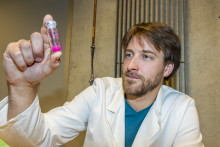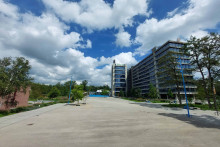Assistant Professor Guillaume Lajoinie received a 250.000 euro NWO Veni grant to develop this idea.
Modern buildings are often built around a steel skeleton. However, this steel backbone is vulnerable to fire: when temperatures reach 400°C, steel starts to soften and easily collapses. A fire-retardant coating of several millimeters is therefore applied on many steel constructions. ‘The principle of these coatings is that a chain of chemical reactions occurs inside when heated,’ Guillaume Lajoinie explains. ‘At about 250 °C, tiny, insulating bubbles are formed inside the coating, expanding it. Also, its consistency changes into a thick, rigid structure, insulating the construction and slowing down the effects of fire.’ Nevertheless, the destruction of countless buildings and the death of thousands of people by fire illustrate the limitations of current coatings. In the USA, fire caused over 2500 deaths and a material loss of 80 billion euro’s in 2015 alone. The 2017 fire in the Grenfell Tower in London is a recent example on the massive toll that fires take on human lives as well as on material when unsuited fire protection is used in buildings.
'When a coating is exposed to heat, bubbles of various sizes are formed'
Suboptimal
The main shortcomings of current fire-retarding coatings are the uncontrollable bubble formation inside the coating. Lajoinie: ‘When a coating is exposed to heat, bubbles of various sizes are formed. This results in a less effective coating expansion, insulation and shielding of the underlying steel as compared to a situation when more even bubbles are formed.’ One way to make insulating properties of protective coatings better, is to stimulate the heat-induced formation of densely-packed, similarly-sized bubbles. However, possibilities to improve current, chemical-based coatings are limited. Therefore, Lajoinie came up with a completely new idea to make buildings more fire-safe: coatings based on physics. The key point of this concept is to design a coating containing microscopic, fluid-filled microcapsules. The fluid absorbs heat and is consequently vaporized. This results in the formation of huge amounts of similarly-sized bubbles and a massive volume increase.
Improve fire-retardant coatings
Lajoinie can rightly be called a ‘bubble expert’. His background in medical imaging such as ultrasound and photo-acoustics required extensive studies of bubble formation. ‘Microcapsules are also experimental contrast agents, and consist of an outer shell of a polymer and a dye, filled with oil,’ Lajoinie explains. ‘In photo-acoustics, laser light heats up the fluid inside the microcapsule really fast and within a fraction of a microsecond, it forms an explosively expanding bubble, thereby generating strong acoustic waves.’ By measuring these waves, an image can be constructed, similar to an ultrasound image. Because new expanding technologies were needed to improve current fire-retardant coatings, Lajoinie’s joined forces with PPG, a company that makes fire retardant coatings for buildings, to develop a completely new coating. In 2018, Lajoinie received a 250.000 euro Veni grant and a 50.000 euro funding from PPG to develop his idea and make a more effective fire-retardant coating. The new coating should offer far greater fire protection resulting in a reduction of fire damage.

Controlled explosion
The first step in developing an effective fire-retardant coating, is the design of a suitable microcapsule. The main criterion for these microcapsules is the controlled formation of bubbles when exposed to heat. It all starts with choosing the right materials: what would be the best polymer to form the microcapsule’s outer shell? Which inside fluid would be most suited? And in what coating resin can these microcapsules best be mixed, to be effective? ‘Using water to fill the microcapsules is most effective,’ Lajoinie states. ‘Water is amazing. It has the highest energy absorption upon vaporization, it may expand over 4500 times when vaporized due to heating and it is safe.’ This massive volume expansion is substantially more than the 100-times expansion of current coatings. By using electron microscopy and high-speed camera’s the behavior of these capsules will be studied in detail. For the outer shell of the capsules, the researchers have to redesign a completely new formulation. The capsules will break down around 300oC, resulting in a controlled explosion and the formation of many evenly-sized bubbles. The new capsule design will be the basis for a coating with better insulating properties and much better protection of the steel parts.
‘The new coating should offer far greater fire protection’
Scientific quest
But there are more challenges. The development of expanding microcapsules is just a first step. Another important aspect of the new coating is the right medium in which to suspend the microcapsules. A resin has the best properties, however, understanding and controlling its interaction with the capsules is still a scientific quest. This resin, solid at room temperature should melt when heated, just before the microcapsules vaporize. It must then solidify again by charring, to stabilize the holes formed by the vaporized bubbles. Charring occurs when this resin is partly carbonized due to heat, resulting in a residue that consists almost entirely out of black carbon. ‘We will develop this resin matrix together with PPG,’ says Lajoinie. ‘It will result in a prototype coating that will be tested in the lab, but also during fire tests where the fire brigade of Twente will be involved.’
Numerous applications
Lajoinie’s coating project will not only result in a new, state of the art, fire-proof coating, but also in a lot of knowledge of the different aspects of the technology. Some members of the users committee want to directly apply the new coating: the fire brigade of Twente has obvious interests in more efficient fireproofing materials for increased safety of people, while partner PPG looks for new coating technologies to create different products for the market. Also, the company ‘Bouwen met Staal’, involved in advice and consulting on fire safety issues, sees some important values of the future coating and wants to boost the steel market with better fireproofing technologies for steel buildings. Other members of the users committee are more interested in applying basic aspects of the science behind the coating, for example, the process of bubble formation in the resin matrix. The company BubClean wants to apply these principles to develop a thermal cleaning system, while the Mesoscale Chemical Systems group of the University of Twente aims to use the bubble formation technology for needle-free injections. Lajoinie: I’m very excited about this users committee and look forward to work together with them in this project and translate our research to the different application fields.’








